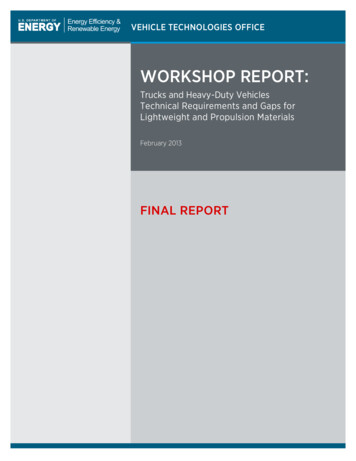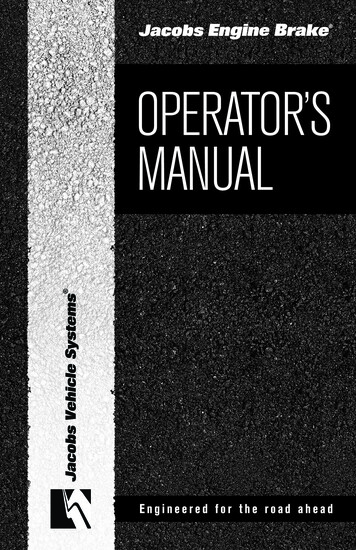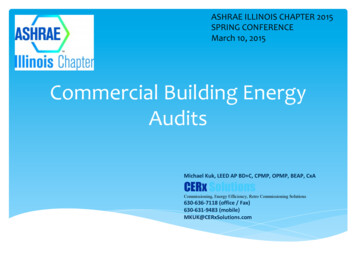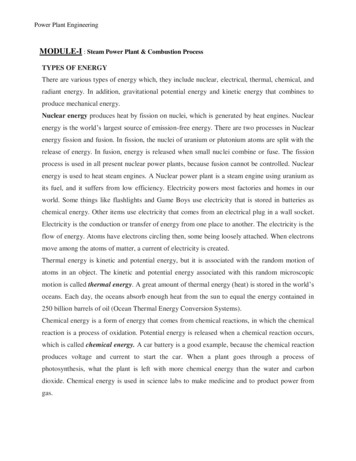
Transcription
VEHICLE TECHNOLOGIES OFFICEWORKSHOP REPORT:Trucks and Heavy-Duty VehiclesTechnical Requirements and Gaps forLightweight and Propulsion MaterialsFebruary 2013FINAL REPORT
This report was prepared as an account of work sponsored by an agency of the UnitedStates government. Neither the United States government nor any agency thereof, norany of their employees, makes any warranty, express or implied, or assumes anylegal liability or responsibility for the accuracy, completeness, or usefulness of anyinformation, apparatus, product, or process disclosed, or represents that its use wouldnot infringe privately owned rights. Reference herein to any specific commercialproduct, process, or service by trade name, trademark, manufacturer, or otherwise,does not necessarily constitute or imply its endorsement, recommendation, or favoringby the United States government or any agency thereof. The views and opinions ofauthors expressed herein do not necessarily state or reflect those of the United Statesgovernment or any agency thereof.
WORKSHOP REPORT: Trucks and Heavy-Duty Vehicles Technical Requirements and Gaps for Lightweight and Propulsion MaterialsEXECUTIVE SUMMARYThe Vehicle Technologies Office (VTO) hosted a Lightweight and Propulsion Materials Workshop inMarch 2011 in Dearborn, Michigan. The Materials area of the Vehicle Technologies Office focuses ondeveloping lightweight materials for structures and propulsion materials for more efficient powertrainsystems. This meeting focused on gaining industry’s perspective on the out-year material requirements oftrucks and heavy duty vehicles (HDVs) as well as current technology gaps that limit adoption of designsutilizing these lighter weight materials. The industry experts who participated in this workshop includedoriginal equipment manufacturers (OEMs) tier-one suppliers and materials suppliers to the light truck andHDV value chain. The output from this workshop will serve as the foundation for the VTO MaterialsRoadmap for trucks and HDVs that also supports the objectives of the U.S. Department of Energy’s(DOE’s) Twenty-First Century Truck (21CT) Partnership. The driver for obtaining this updated input is tosupport the Administration’s goals for reducing greenhouse gas emissions and U.S. dependence onpetroleum. In support of these goals, the mission of the VTO is to develop more energy-efficient andenvironmentally friendly transportation technologies while meeting or exceeding drivers’ performanceexpectations and environmental requirements.Following is a list of the primary objectives of this workshop: To understand industry’s needs with respect to out-year requirements and quantitative metrics To understand technology gaps that inhibit development of materials that will help the industry attainthe following objectives:- Designing the next generation of high-efficiency powertrains- Minimize efficiency penalties by reducing exhaust emissions- Provide aerodynamic solutions with minimal weight penalty- Develop lightweighting that improves the fuel economy of light duty trucks and the freightefficiency of HDVs- Reduce petroleum dependence by developing propulsion materials that are compatiblewith advanced fuels-Significantly accelerate the adoption of these technologies by expanding the capabilitiesof modeling and design tools To provide a forum for input by industry experts and for developing consensus on targets, gaps, andperformance metricsThe purpose of the workshop is to understand what technologies must be developed in order to realizethese objectives. The workshop and report serve as a benchmark of the current state-of-the-art for trucksand heavy duty vehicle structural and propulsion systems, identifying future performance requirementsand the technology gaps that inhibit industry’s ability to realize these goals today. This workshop reportalso identifies technical goals for both truck systems and lightweight and structural materials.Heavy duty vehicles cover body-on-frame vehicles classified by the Gross Vehicle Weight Ratings(GVWR) system as Class 1 through 8. The body-on-frame architecture is required for these types ofvehicles to carry substantial payloads which can be significantly greater than the load carried by a lightduty passenger car. This range of vehicles includes the higher volume, Body-on-Frame pickup trucks andFINAL REPORTii
WORKSHOP REPORT: Trucks and Heavy-Duty Vehicles Technical Requirements and Gaps for Lightweight and Propulsion Materialsvans in Classes 1 through 3, the medium-duty trucks and utility/delivery vehicles in Classes 4 through 6,and the heavy-duty over-the-highway and vocational vehicles in Classes 7 and 8. 1,2,3 Because trucks at theextremes of the classification spectrum (Class 1 & 2 and Class 7 & 8) represent 93% of the fuel used bytrucks (see Figure ES1 below), this report will focus primarily on these vehicle classes. However, manyof the technology needs and material applications are applicable across the full range of trucks with bodyon-frame architectures.Figure ES 1: Truck Classification by the U.S. Department of Transportation’sGVWR and Vehicle Inventory Use Service (VIUS) CategoriesFINAL REPORTiii
WORKSHOP REPORT: Trucks and Heavy-Duty Vehicles Technical Requirements and Gaps for Lightweight and Propulsion MaterialsMaterial technologies are crosscutting and will enable components and systems to perform at the levelrequired by future light truck and HDVs. The truck manufacturing community needs enabling solutions torealize materials requirements in applications for high-performance engines, structural body and chassismembers, and drivetrain components. New and improved materials, processing and manufacturing, andimprovements in design are needed to increase the thermal efficiency and fuel economy of both gasolineand diesel engines.The current effort by the SuperTruck Program, a collaboration between DOE VTO and industry partnersin HDVs, takes a holistic approach to increasing freight efficiency through “clean sheet” design of theClass 8 vehicle resulting in improved aerodynamics, engine and powertrain efficiencies, and reducedweight of the tractor and trailer. For example, efficient design coupled with devices that streamline thetruck can significantly improve vehicle aerodynamics. These devices can have a significant impact ofvehicle energy efficiency, especially at highway speeds. However, while these aerodynamic treatmentscan improve efficiency, they can also add weight and impact cargo capacity. Innovations in materials anddesign are needed to maximize flexibility while minimizing or eliminating the need for additional weight.The powertrain consists of the engine and drivetrain (i.e., transmission, clutch, drive shafts, and driveaxles), tire/wheel assemblies, and brakes. In Class 7 and 8 vehicles, the powertrain accounts for about40% of the total weight. By increasing specific power density, advanced materials could enable enginedownsizing and reduced vehicle weight. These materials would require significantly improvedmechanical properties while also providing the ability to operate in extreme thermal and tribologicalconditions. Opportunities for weight reduction in the drivetrain include lighter weight engines,transmissions, braking systems, wheels, and tires.The body and chassis of modern HDVs are currently made from a wide variety of materials ranging fromhigh-strength steel to glass-reinforced composites. This diversity combined with relatively low productionvolumes provides an opportunity for additional weight reduction in the body and chassis while alsoserving as a potential entry point for validating advanced lightweight material designs. In fact, the heavyduty industry has significant experience lightweighting specific components. However, expanding thesetechniques to the entire vehicle requires design experience with the available new materials, joiningtechniques for multi-material approaches, process databases, optimized manufacturing techniques, theavailability of advanced materials, established repair technologies, and lower costs materials. Thesebarriers contribute to delays in commercial adoption of designs utilizing lighter weight materials.Significant advances are needed to bridge these gaps while maintaining or improving the performance,durability, utility, and safety of the vehicle.The industry experts provided stretch goals for weight reductions of different vehicle systems for both the2025 and 2050 horizons. Table ES.1 contains targets for weight reduction of systems and the total vehiclealong with intermediate targets which DOE interpolated between the goals provided at the workshop.This draft report provides an opportunity for industry to review the data documented here and to ensurethat it accurately represents the weight reduction potential based on information provided to DOE at theworkshop.FINAL REPORTiv
WORKSHOP REPORT: Trucks and Heavy-Duty Vehicles Technical Requirements and Gaps for Lightweight and Propulsion MaterialsTable ES 1: Targets for Weight Reductionsfor Systems in Heavy Duty Trucks 2020–205020202025203020402050Class 8 TractorComponent GroupWheels and TiresChassis/FrameDrivetrain & SuspensionMisc. Accessories/SystemsTruck Body StructurePowertrainTotal Class 8 1%Trailer (53 ft)Component GroupWheels and TiresChassis/FrameSuspensionBox/OtherTotal Truck and TrailerCombined TotalsFINAL REPORTv
WORKSHOP REPORT: Trucks and Heavy-Duty Vehicles Technical Requirements and Gaps for Lightweight and Propulsion MaterialsACKNOWLEDGEMENTSWe would like to acknowledge the late Dr. Sidney Diamond whose leadership in materials researchresulted in the 2001 Twenty-First Truck Partnership Materials Technical Roadmap that has been a stellarexample of what a roadmap should be.FINAL REPORTvi
WORKSHOP REPORT: Trucks and Heavy-Duty Vehicles Technical Requirements and Gaps for Lightweight and Propulsion MaterialsACRONYMS AND NVHOEMR&DRPMSISMCSUVVIUSVTOAdvanced combustion engineAdvanced high-strength steelCarbon FiberCarbon fiber compositesCompression ignitionCompacted graphite ironU.S. Department of EnergyU.S. Department of TransportationEnergy Information AdministrationGlass-fiber reinforced plasticHeavy-Duty VehicleMetal matrix compositesNoise, vibration, and harshnessOriginal equipment manufacturersResearch and developmentRevolutions per minuteSpark ignitionSheet molding compoundSport utility vehicleVehicle Inventory and Use SurveyVehicle Technologies OfficeFINAL REPORTvii
CONTENTSExecutive Summary . iiAcknowledgements . viAcronyms and Abbreviations. vii1Introduction .1BASELINES OF TRUCK WEIGHTS AND TRENDS. 41.1Weight of Light-Duty Trucks (Classes 1 through 3) . 41.2Weight of Heavy-Duty Trucks (Classes 7 and 8) . 61.3Class 8 Semi Trailers. 72 Vehicle Systems and Material Requirements . 82.1Body and Cab Structures . 82.1.1Body on Frame Architecture . 82.1.2 Targets and Key Metrics. 82.1.2.1 Light-Duty Truck Body . 82.1.2.2 Heavy-Duty Truck Body and Cab . 92.1.3 Technology Gaps-Body And Cab Structures . 102.2Components for Chassis Structures .112.2.1 Key Metrics and Targets.122.2.1.1 Light-Duty Truck and SUV Chassis .122.2.1.2 Heavy-Duty Vehicle Chassis .122.2.2 Technology Gaps-Chassis Structures and Components .132.3Powertrain: Engines and Transmission .142.3.2.1 Light-Duty Truck Propulsion Systems.152.3.2.2 Heavy-Duty Propulsion Systems .162.3.3 Technology Gaps-Powertrain . 173 The Impact of Materials on Vehicle Efficiency . 203.1Material-Specific Technology Gaps that Prohibit the Realization of EfficiencyImprovements Today .213.2Carbon Fiber Material and Carbon Fiber Composites.213.2.1 Key Metrics and Targets-Carbon Fiber and Carbon Fiber Composites . 223.2.2 Technology Gaps-Carbon Fiber . 223.2.3 Technology Gaps-Carbon Fiber Composites .24
3.3Magnesium. 253.3.1 Key Metrics and Targets-Magnesium. 253.3.2 Technology Gaps-Magnesium .263.4Aluminum . 273.4.1 Key Metrics and Targets-Aluminum.283.4.2 Technology Gaps-Aluminum .283.5Glass-Fiber Reinforced Polymer Composites .293.5.1 Key Metrics and Targets- Glass-Fiber Reinforced Polymer Composites . 293.5.2 Technology Gaps – Glass-Fiber Reinforced Polymer Composites . 303.6Advanced Materials (e.g., Titanium, Ni-Based Alloys, MMCs). 323.6.1 Key Metrics and Targets-Advanced Materials . 323.6.2 Technology Gaps -Advanced Materials. 323.7High-Strength Steels and Advanced High-Strength Steels (Structural). 333.7.1 Key Metrics and Targets-Advanced High-Strength Steels (AHSS) andHigh-Strength Steels (HSS).343.7.2 Technology Gaps – High-Strength Steels and Advanced High-StrengthSteels .343.8Steel and Cast Iron (Propulsion) . 353.8.1 Key Metrics and Targets-Steel and Cast Iron . 353.8.2 Technology Gaps – Steel and Cast Iron .364 Summary . 394.1Systems .394.2Materials . 40Appendix 1. List of Meeting Participants . 43Appendix 2. References . 46List of FiguresFigure ES 1: Truck Classification by the U.S. Department of Transportation’s GVWR andVehicle Inventory Use Service (VIUS) Categories . iiiFigure 1: Truck Classification by Gross Vehicle Weight. 1Figure 2: Utilization of Motor Fuel by Highway Vehicles . 2Figure 3: 2010 On-Road Fuel Consumption by Vehicle Class. 4Figure 4: Weight Trends for Light-Duty Trucks . 5Figure 5: Weight Distribution of Light Truck Systems . 6
Figure 6: Weight Distribution of Heavy Duty Vehicle Systems. 7Figure 7: Materials and Peak Cylinder Pressure Capabilities .21List of TablesTable ES 1: Targets for Weight Reductions for Systems in Heavy Duty Trucks 2020–2050. vTable 1: Light Truck Body and Cab Goals and Metrics. 9Table 2: Heavy-Duty Vehicle Body and Cab Goals and Metrics . 10Table 3: Light Truck Chassis Metrics and Targets.12Table 4: Heavy-Duty Vehicle Chassis Metrics and Targets.13Table 5: Light Truck Propulsion Metrics and Targets.16Table 6: Heavy-Duty Vehicle Propulsion Metrics and Targets . 17Table 7: Materials’ Weight Reduction Potential . 20Table 8: Carbon Fiber and Carbon Fiber Composites Metrics and Targets . 23Table 9: Magnesium Metrics and Targets .26Table 10: Aluminum Metrics and Targets .28Table 11: Glass-Fiber Reinforced Plastic Metrics and Targets .31Table 12: Advanced Materials Metrics and Targets. 32Table 13: Advanced High Strength Steels (AHSS) and High Strength Steels (HSS) Metricsand Targets.34Table 14: Steel and Cast Iron Metrics and Targets.36Table 15: Key Technical Gaps for Systems for Trucks and HDVs .39Table 16: Key Technical Gaps for Materials for Trucks and HDVs.41
WORKSHOP REPORT: Trucks and Heavy-Duty Vehicles Technical Requirements and Gaps for Lightweight and Propulsion Materials1INTRODUCTIONThe category of vehicles described as trucks includes vehicles with a body-on-frame architecture. Thisdesign allows these vehicles to carry or tow heavy loads that may exceed the weight of the truck itself.Unlike passenger cars, which are categorized by the size and weight of the vehicle, trucks are groupedaccording to their carrying capacity or Gross Vehicle Weight Rating (GVWR), which includes thecombined weight of the vehicle and cargo. Trucks are segmented into 8 size classes ranging from 1–8; theEnvironmental Protection Agency (EPA) segments the Class 2 trucks into Class 2A (6,001–8,500 lbsGVWR) and 2B (8,501–10,000 lbs GVWR). The U.S. Department of Transportation (DOT) FederalHighway Administration’s Vehicle Inventory and Use Survey (VIUS) lists Class 1, 2, and 3 trucks andsport utility vehicles (SUVs) as “Light Duty,” 4, 5, and 6 trucks as “Medium Duty,” and 7–8 trucks as“Heavy Duty.”Figure 1: Truck Classification by Gross Vehicle Weight 4The volumes of trucks sold in the United States vary greatly by class. In 2011, a total of 213,000 heavyduty trucks (Classes 7 and 8), 100,000 medium duty trucks (Classes 4–6), and 6.6 million light duty(Classes 1 and 2) sold, of which 1,783,000 were pickup trucks. Over 300,000 units of each of the mostpopular light duty trucks were sold (Ford F150 and Chevrolet Silverado) whereas only 52,276 units of themost popular Class 8 trucks were sold (All Freightliner Class 8 Trucks).5FINAL REPORT1
WORKSHOP REPORT: Trucks and Heavy-Duty Vehicles Technical Requirements and Gaps for Lightweight and Propulsion MaterialsThe United States imports over half of all petroleum. This petroleum consumption represents a strategicrisk and an economic liability. According to the Energy Information Administration, the transportationsector accounts for over two-thirds of all U.S. petroleum consumption. Trucks represent over 50% of thepetroleum used in transportation and are the largest growth sector with respect to petroleum consumption.Figure 2 illustrates the utilization of fuel by highway vehicles from 1970 to today.6 These data show thatwhile the percentage of total consumption of fuel by cars decreased slightly from 40% in 1970 to 37%–38% in 2010, the total use of fuel by light duty and heavy duty trucks climbed to over 50% in 20101270%Million Barrels Per Day1060%850%640%430%2Percentage of fuel used by Light- and Heavy-duty arsPickupsOther% Pickups and HDVsFigure 2: Utilization of Motor Fuel by Highway VehiclesTo address the risks associated with petroleum dependence, the U.S. Department of Energy VehicleTechnologies Office (VTO) works with industry, researchers, academia, and stakeholders to reducepetroleum consumption by improving vehicle efficiency, developing alternatives to petroleum, andexploring transportation technologies that are less reliant on petroleum. Within this framework, theMaterials Technology Subprogram addresses the materials requirements of existing and futuretransportation systems as identified by VTO and its partners.In order to update our current understanding of industry needs, DOE held a materials workshop withindustry experts on automotive and heavy-duty vehicle systems representing OEMs, manufacturers, andsuppliers in Dearborn Michigan in March 2011. The purpose of the workshop was to:FINAL REPORT2
WORKSHOP REPORT: Trucks and Heavy-Duty Vehicles Technical Requirements and Gaps for Lightweight and Propulsion Materials Understand industry’s needs with respect to out-year requirements and quantitative metrics Understand technology gaps in:- Lightweighting to improve the fuel economy of light duty trucks and the freight efficiency ofHDVs- Realizing the next generation high efficiency powertrains- Minimizing efficiency penalties of reducing exhaust emissions- Reducing petroleum dependence with propulsion materials compatible with advanced fuels- Enabling aerodynamic solutions with minimal weight penalty- Accelerating adoption of these technologies by expanding capabilities for computationalmodeling and design tools Provide a forum for input by industry experts and for developing consensus on targets, gaps, andperformance metricsThe results of the workshop will provide the basis of a materials technology roadmap by identifying, at asystems level, the material requirements necessary for light- and heavy-duty trucks to achieve themaximum possible efficiency. This draft report documents the consensus reached on stretch targets,metrics for performance, priorities on technology gaps, and areas of synergy across materials and vehicleclasses.The workshop report documents the materials requirements and gaps for each of the three major systems(body and cab, chassis and suspension, and powertrain) that comprise the majority of vehicle weight.Using a combination of data on EPA vehicle classes, composites of teardowns by third parties, andindustry interviews, the DOE Materials team established quantitative baselines for each relevant classprior to the workshop so that stretch targets could be established. Greater emphasis is placed on thoseclasses that represent the best opportunity for petroleum displacement, as illustrated in Figure 3.Passenger cars account for 38% of all petroleum used by on-road transportation. This percentage is thehighest amount used by any single class of vehicle. This significant rate of use is followed closely by lighttrucks (Classes 1 and 2) that use 24% and 17% respectively. The majority of the remaining fuel use (15%)is attributed to Class 8 heavy-duty trucks. Trucks in Classes 3 through 7 account for only 5% of on-roadmotor fuel use in the United States. This workshop report focuses on opportunities in light-duty trucks(Class 1 and 2) and Class 8 Semi tractor trailer combination heavy-duty vehicles (HDVs).FINAL REPORT3
WORKSHOP REPORT: Trucks and Heavy-Duty Vehicles Technical Requirements and Gaps for Lightweight and Propulsion 0%CarsClass 1 Class 2 Class 3 Class 4 Class 5 Class 6 Class 7 Class 8Figure 3: 2010 On-Road Fuel Consumption by Vehicle Class(Vehicles Covered by this Report Shown in Blue) 7BASELINES OF TRUCK WEIGHTS AND TRENDS1.1Weight of Light-Duty Trucks (Classes 1 through 3)The weight of light-duty trucks has increased steadily from 1980 to 2010, as shown in Figure 4.8 Theaverage curb weight of all pickup trucks in 2010 was about 4,700 lbs, an increase of over 1,000 poundssince 1980. The average GVWR for these trucks is about 7,000 lbs. Most offerings of pickups in the EPAsmall pickup category ended in 2006 as the demand for larger trucks continued to dominate the market.The trend for fuel economy of mid-size pickups declined from 22 mpg in 1980 to 17 mpg in 2002 andthen rebounded to 20 mpg in 2010.FINAL REPORT4
WORKSHOP REPORT: Trucks and Heavy-Duty Vehicles Technical Requirements and Gaps for Lightweight and Propulsion 000Fuels Economy (mpg)Vehicle Weight (lbs)500017.015.0Small PickupMidsize PickupLarge 198719851983198119790Midsize Pickup mpgFigure 4: Weight Trends for Light-Duty TrucksFigure 5 shows that the weight distribution is rather even across the three major systems: body and cab,suspension and frame, and powertrain. Therefore, the weight and mechanical requirements of all of thesesystems must be addressed to achieve maximum improvement in vehicle efficiency.FINAL REPORT5
WORKSHOP REPORT: Trucks and Heavy-Duty Vehicles Technical Requirements and Gaps for Lightweight and Propulsion MaterialsOther1%Powertrain36%Cab/Body41%Chassis andSuspension22%Figure 5: Weight Distribution of Light Truck Systems (Pickup Trucks)1.2Weight of Heavy-Duty Trucks (Classes 7 and 8)The weight of the typical heavy-duty truck increased from about 16,500 lbs in 1999 to between 17,500and 19,500 lbs in 2012. Three factors are responsible for much of this weight increase: 1) enginedisplacement and horsepower increased from about 12 liters and 350 hp in 1999 to 15 liters and 450 hptoday, resulting in a weight increase of about 300 lbs.; 2) additional requirements for exhaust aftertreatment systems and emissions systems resulting in a weight increase of about 400 lbs.; and the weightof the cooling system increased by almost 200 lbs. Typically, day cabs are about 5,000 lbs lighter thantrucks, with sleeper cabs that typically weigh 19,500 lbs. Many trucks now include aerodynamic devicesto improve fuel economy; however, a full truck and trailer aerodynamic package can weigh up to 4,000lbs. In addition, many manufacturers offer Auxiliary Power Units to comply with anti-idling laws; theseunits can weigh up to 600 lbs. Although these changes may not have a negative impact on fuel economy,the increase in truck weight will negatively impact overall cargo capacity and freight efficiency whencalculated on a delivered ton-mile/gallon basis. Figure 6 shows that the majority of Class 8 tractor weightis in the powertrain (48%), followed by the chassis/suspension (31%), and the body/cab (18%).FINAL REPORT6
WORKSHOP REPORT: Trucks and Heavy-Duty Vehicles Technical Requirements and Gaps for Lightweight and Propulsion MaterialsOther3%Cab/Body18%Powertrain48%Chassis andSuspension31%F
WORKSHOP REPORT: Trucks and Heavy-Duty Vehicles Technical Requirements and Gaps for Lightweight and Propulsion Materials FINAL REPORT. Table ES 1: Targets for Weight Reductions for Systems in Heavy Duty Trucks 2020–2050 . 2020 2025 2030 2040 2050 . Class 8 Tractor Component











